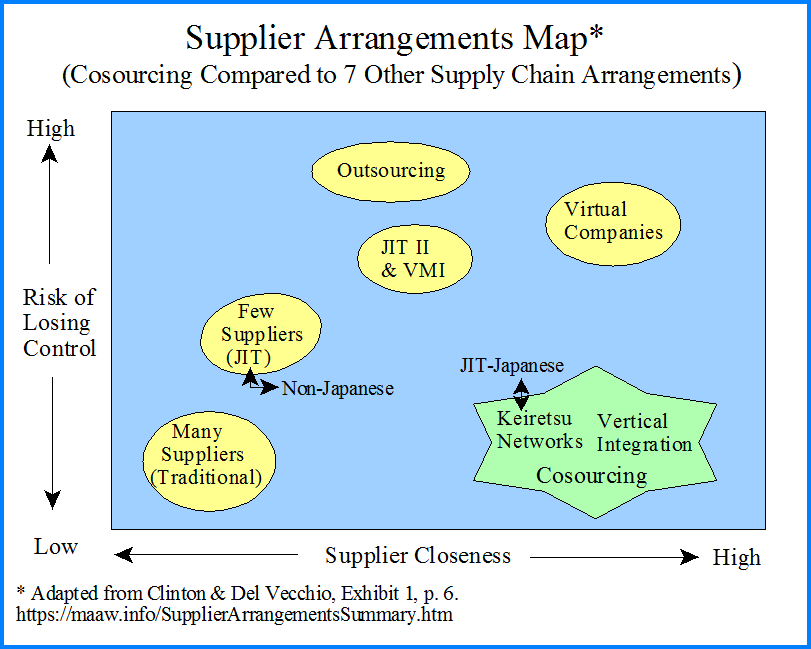
Provided by James R. Martin, Ph.D., CMA
Professor Emeritus, University of South Florida
Outsourcing &
Make vs. Buy Main | Value Chain/Supply Chain Main
The following graphic illustration and tables were adapted from two articles by Clinton and Del Vecchio. The first illustration (based on Exhibit 1 in their September/October 2002 article 1 ) compares cosourcing with seven other supplier arrangements in terms of the risk of losing control (vertical axis), and the closeness of the relationship between supplier and manufacturer (horizontal axis). As indicated in the graphic, the Japanese Keiretsu is unique in that the loss of control is very low in such networks and the supplier relationships are very close. Since U.S. firms cannot duplicate the Japanese Keiretsu closed-loop cultural system, cosourcing is recommended by Clinton and Del Vecchio as an alternative. Cosourcing can provide benefits similar to those of the Japanese Keiretsu arrangements without the high cost of vertical integration.

The following table provides a note on the distinguishing features of the eight supplier arrangements, and compares the arrangements in terms of the degree of supplier closeness and the issue related to control loss.
|
Supplier Arrangements Summary
|
|||
| Supplier Arrangement | Distinguishing Feature | Degree of Supplier Closeness |
Control Issue Characteristics |
| Many Suppliers | Tradition approach. Typically uses a bid system. Suppliers not viewed as a strategic issue. | Little or no closeness or loyalty. Transaction based relationships. | Buyers and suppliers are independent. |
| Few Suppliers (e.g., JIT) |
Wide range of relationships. | Closeness is encouraged with emphasis on quality. | Buyers keep control, but suppliers are more active in the buyer's activities. Loss of control is greater than in a traditional system, Keiretsu, vertically integrated or cosourcing arrangement. |
| JIT II and VMI** | In-plant supplier reps. Equivalent to outsourcing the purchasing function. | Close formal in-house arrangements. | Buyers keep control of manufacturing, but suppliers control inventory and purchasing functions. |
| Keiretsu Networks | Culture based affiliations where families of companies in a closed-loop system serve in a supply chain hierarchy. | Extreme closeness where the suppliers exist to serve the parent in a cultural family type arrangement. | Buyer controls suppliers who exist to serve the buyer. |
| Virtual Companies | Usually short term project oriented with supplier serving an exclusive buyer. | Close in terms of purpose, but temporary. | Control by project leader where buyer and supplier work together on a common project. |
| Outsourcing | Supplier controls the processing. | Close relationship where buyer is dependent on supplier. | Buyer loses control except for output specifications. |
| Vertical Integration | Parent-subsidiary relationship with sub serving as supplier. | Ultimate closeness. | Buyer maintains control by purchasing suppliers. |
* Adapted from Clinton & Del Vecchio Exhibit 2, p. 8, in the September/October article. ** Vendor managed inventory. |
|||
The table below combines the control threats related to JIT with the potential benefits related to JIT from cosourcing. This table is based on Exhibits 1 and 2 in Clinton and Del Vecchio's second article on cosourcing 2 .
| JIT Control Threats and the Cosourcing Solution* | ||
| JIT Control Threats | Cosourcing Benefits Related to JIT | |
| Timeliness | Related to delivery, schedule changes, design changes, customer needs, and requirements for simultaneous efforts. | Involves specialized technologies and expertise, and facilitates simultaneous achievement of objectives within a limited timescale. |
| Quality | Related to loss of in-house knowledge, and quality of inputs, outputs and activities. | Facilitates sharing knowledge, opportunities for learning and training in-house on new technology, achieving specialization with limited costs, and increased resources to address any issue. |
| Consistency | Related to operational consistency and the integration of activities. | Prevents loss of undocumented knowledge that occurs with outsourcing, increases achieving strategic goals through interaction of buyer and supplier on process changes. |
| Cost | Relates to cost control of the purchasing function, life-cycle costs, the capital investments needed, capacity utilization, and company size. | Emphasis on lowest cost supplier arrangement (not the lowest price), leads to supplier's capital investment in specialized equipment, maximizes value-added activity with minimum in-house staff, provides joint funding, cost sharing, and combined purchasing power. |
| * Adapted from Clinton & Del Vecchio Exhibits 1 and 2, pp. 32 and 36 in their November/December article. | ||
__________________________________________
Clinton, B. D. and S. C. Del Vecchio. 2002. Cosourcing in manufacturing. Journal of Cost Management (September/October): 5-12. (Summary).
Clinton, B. D. and S. C. Del Vecchio. 2002. Cosourcing in manufacturing - Just in time. Journal of Cost Management (November/December): 30-37. (Summary).
Other related summaries:
Cooper, R. and R. Slagmulder. 2003. Interorganizational costing, Part 1. Cost Management (September/October): 14-21. (Summary).
Cooper, R. and R. Slagmulder. 2003. Interorganizational costing, Part 2. Cost Management (November/December): 12-24. (Summary).
Dyer, J. H. 1996. How Chrysler created an American keiretsu. Harvard Business Review (July-August): 42-43, 46-47, 50-56. (Summary).